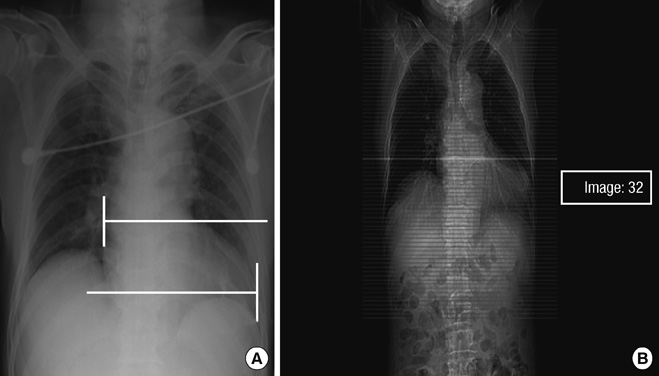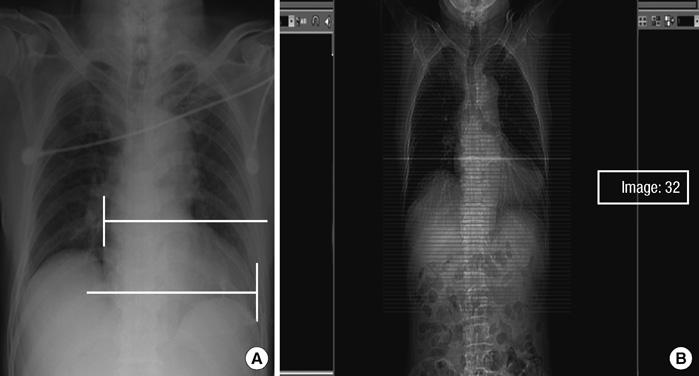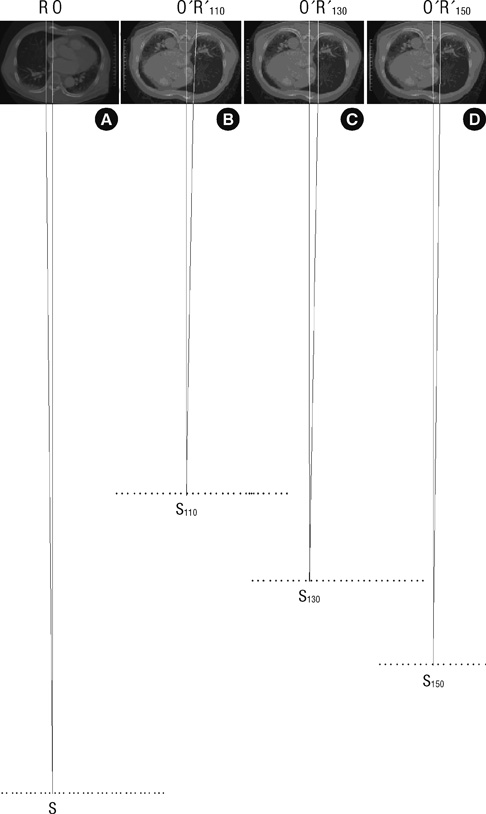J Korean Med Sci.
2011 Nov;26(11):1446-1453. 10.3346/jkms.2011.26.11.1446.
Calculation of the Cardiothoracic Ratio from Portable Anteroposterior Chest Radiography
- Affiliations
-
- 1Department of Emergency Medicine, Kangwon National University Hospital, Kangwon National University School of Medicine, Chuncheon, Korea.
- 2Department of Internal Medicine, Kangwon National University Hospital, Kangwon National University School of Medicine, Chuncheon, Korea. medfman@kangwon.ac.kr
- 3Department of Radiology, Kangwon National University Hospital, Kangwon National University School of Medicine, Chuncheon, Korea.
- KMID: 1123444
- DOI: http://doi.org/10.3346/jkms.2011.26.11.1446
Abstract
- Cardiothoracic ratio (CTR), the ratio of cardiac diameter (CD) to thoracic diameter (TD), is a useful screening method to detect cardiomegaly, but is reliable only on posteroanterior chest radiography (chest PA). We performed this cross-sectional 3-phase study to establish reliable CTR from anteroposterior chest radiography (chest AP). First, CDChest PA/CDChest AP ratios were determined at different radiation distances by manipulating chest computed tomography to simulate chest PA and AP. CDChest PA was inferred from multiplying CDChest AP by this ratio. Incorporating this CD and substituting the most recent TDChest PA, we calculated the 'corrected' CTR and compared it with the conventional one in patients who took both the chest radiographies. Finally, its validity was investigated among the critically ill patients who performed portable chest AP. CDChest PA/CDChest AP ratio was {0.00099 x (radiation distance [cm])} + 0.79 (n = 61, r = 1.00, P < 0.001). The corrected CTR was highly correlated with the conventional one (n = 34, difference: 0.00016 +/- 0.029; r = 0.92, P < 0.001). It was higher in congestive than non-congestive patients (0.53 +/- 0.085; n = 38 vs 0.49 +/- 0.061; n = 46, P = 0.006). Its sensitivity and specificity was 61% and 54%. In summary, reliable CTR can be calculated from chest AP with an available previous chest PA. This might help physicians detect congestive cardiomegaly for patients undergoing portable chest AP.
Keyword
MeSH Terms
Figure
Reference
-
1. Danzer CS. The cardiothoracic ratio. Am J Med Sci. 1919. 157:513–554.2. Schlett CL, Kwait DC, Mahabadi AA, Bamberg F, O'Donnell CJ, Fox CS, Hoffmann U. Simple area-based measurement for multidetector computed tomography to predict left ventricular size. Eur Radiol. 2010. 20:1590–1596.3. Clark AL, Coats AJ. Unreliability of cardiothoracic ratio as a marker of left ventricular impairment: comparison with radionuclide ventriculography and echocardiography. Postgrad Med J. 2000. 76:289–291.4. Philbin EF, Garg R, Danisa K, Denny M, Gosselin G, Hassapoyannes C, Horney A, Johnstone DE, Lang RM, Ramanathan K, Safford RE, Sarma RJ, Weiss R, Williford WO, Fleg JL. Digitalis Investigation Group. The relationship between cardiothoracic ratio and left ventricular ejection fraction in congestive heart failure. Arch Intern Med. 1998. 158:501–506.5. Dakin J, Griffiths M. The pulmonary physician in critical care 1: pulmonary investigations for acute respiratory failure. Thorax. 2002. 57:79–85.6. Zaman MJ, Sanders J, Crook AM, Feder G, Shipley M, Timmis A, Hemingway H. Cardiothoracic ratio within the "normal" range independently predicts mortality in patients undergoing coronary angiography. Heart. 2007. 93:491–494.7. Giamouzis G, Sui X, Love TE, Butler J, Young JB, Ahmed A. A propensity-matched study of the association of cardiothoracic ratio with morbidity and mortality in chronic heart failure. Am J Cardiol. 2008. 101:343–347.8. Berman M, Aravot D, Ben-Gal T, Sahar G, Sagie A, Vidne B. Cardiothoracic ratio: important prognostic tool in heart failure patients who are candidates for heart transplantation. Transplant Proc. 2000. 32:727–728.9. Shah S, Davies MK, Cartwright D, Nightingale P. Management of chronic heart failure in the community: role of a hospital based open access heart failure service. Heart. 2004. 90:755–759.10. Nolan J, Batin PD, Andrews R, Lindsay SJ, Brooksby P, Mullen M, Baig W, Flapan AD, Cowley A, Prescott RJ, Neilson JM, Fox KA. Prospective study of heart rate variability and mortality in chronic heart failure results of the United Kingdom heart failure evaluation and assessment of risk trial (UK-Heart). Circulation. 1998. 98:1510–1516.11. Lauder IJ, Milne JS. Longitudinal study of heart size in older people. Br Heart J. 1976. 38:1286–1290.12. Potter JF, Elahi D, Tobin JD, Andres R. Effect of aging on the cardiothoracic ratio of men. J Am Geriatr Soc. 1982. 30:404–409.13. Kabala JE, Wilde P. The measurement of heart size in the antero-posterior chest radiograph. Br J Radiol. 1987. 60:981–986.14. van der Jagt EJ, Smits HJ. Cardiac size in the supine chest film. Eur J Radiol. 1992. 14:173–177.15. Milne EN, Burnett K, Aufrichtig D, McMillan J, Imray TJ. Assessment of cardiac size on portable chest films. J Thorac Imaging. 1988. 3:64–72.16. Hammermeister KE, Chikos PM, Fisher L, Dodge HT. Relationship of cardiothoracic ratio and plain film heart volume to late survival. Circulation. 1979. 59:89–95.17. Ahn YO, Yoo KY, Park BJ. Manual for medical statistics. 1996. Seoul: Seoul National University Press;321–322.
- Full Text Links
- Actions
-
Cited
- CITED
-
- Close
- Share
- Similar articles
-
- A comparision of upright chest PA and supine chest AP view
- A study on computed tomography cardiothoracic ratio in predicting left ventricular systolic dysfunction
- Exposure to lonizing Radiation in the Emergency Department from Performed Portable Radiographs
- Correlation of Cardiothoracic Ratio and Right Ventricular Systolic Pressure in Systemic Sclerosis
- Absorbed and effective dose for periapical radiography using portable and wall type dental X-ray machines





